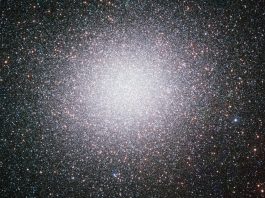In a study to be published in Astrophysical Journal Letters researchers have obtained the first direct measurement of the average acceleration of the Milky Way and its stars.
The expansion of the Universe is accelerating due to dark matter. Within galaxies, stars also experience an acceleration, though this is due to some combination of dark matter and the stellar density.
This new study, led by Sukanya Chakrabarti at the Institute for Advanced Study with collaborators from Rochester Institute of Technology, University of Rochester, and University of Wisconsin-Milwaukee, used pulsar data to clock the radial and vertical accelerations of stars within and outside of the galaxy. Based on these new high-precision measurements and the known amount of visible matter in the galaxy, researchers were then able to calculate the Milky Way’s dark matter density without making the usual assumption that the galaxy is in a steady-state.
Chakrabarti, the paper’s lead author and a current Member and IBM Einstein Fellow at the Institute for Advanced Study, said: “Our analysis not only gives us the first measurement of the tiny accelerations experienced by stars in the galaxy, but also opens up the possibility of extending this work to understand the nature of dark matter, and ultimately dark energy on larger scales.”
This study indicates that the change in a star’s velocities is occurring at a few centimetres per second. To detect this subtle motion the research team relied on the ultraprecise time-keeping ability of pulsars that are widely distributed throughout the galaxy and halo – a diffuse spherical region that surrounds the galaxy.
Extending outwards approximately 300,000 light years from the galactic centre, the halo may provide important clues to understanding dark matter, which accounts for 90% of the galaxy’s mass and is highly concentrated above and below the star-dense galactic plane. Stellar motion in this region can be influenced by dark matter. Utilising the local density measurements obtained through this study, researchers will now have a better understanding of how and where to look for dark matter.
The Milky Way is influenced by a turbulent history of galactic mergers and continues to be perturbed by external dwarf galaxies like the Small and Large Magellanic Clouds. As a result, stars do not have flat orbits and tend to follow a path similar to that of a warped vinyl record, crossing above and below the galactic plane. One of the key factors that enabled this direct observational approach was the use of pulsar data compiled from international collaborations, including NANOGrav (North American Nanohertz Observatory for Gravitational Waves) that has obtained data from the Green Bank and Arecibo telescopes.









